CHC33015 Certificate III Individual Support Disability Work Portfolio
VerifiedAdded on 2023/06/14
|28
|8183
|67
Portfolio
AI Summary
This work placement portfolio documents activities undertaken for the CHC33015 Certificate III in Individual Support (Disability). It includes individual care plans developed for three clients, addressing care alerts, communication, mobility, and other essential needs. The portfolio also features reflective journal entries detailing discussions with two clients about their personal goals, focusing on empowerment, accessing support services, and utilizing effective communication strategies. The student reflects on their role in facilitating community participation, social inclusion, and overall well-being for the clients. The assignment also includes workplace assessment by an Open Colleges’ Work Place Assessor (WPA) observing the student facilitating access to choices that assist people with disability to reach their personal goals.
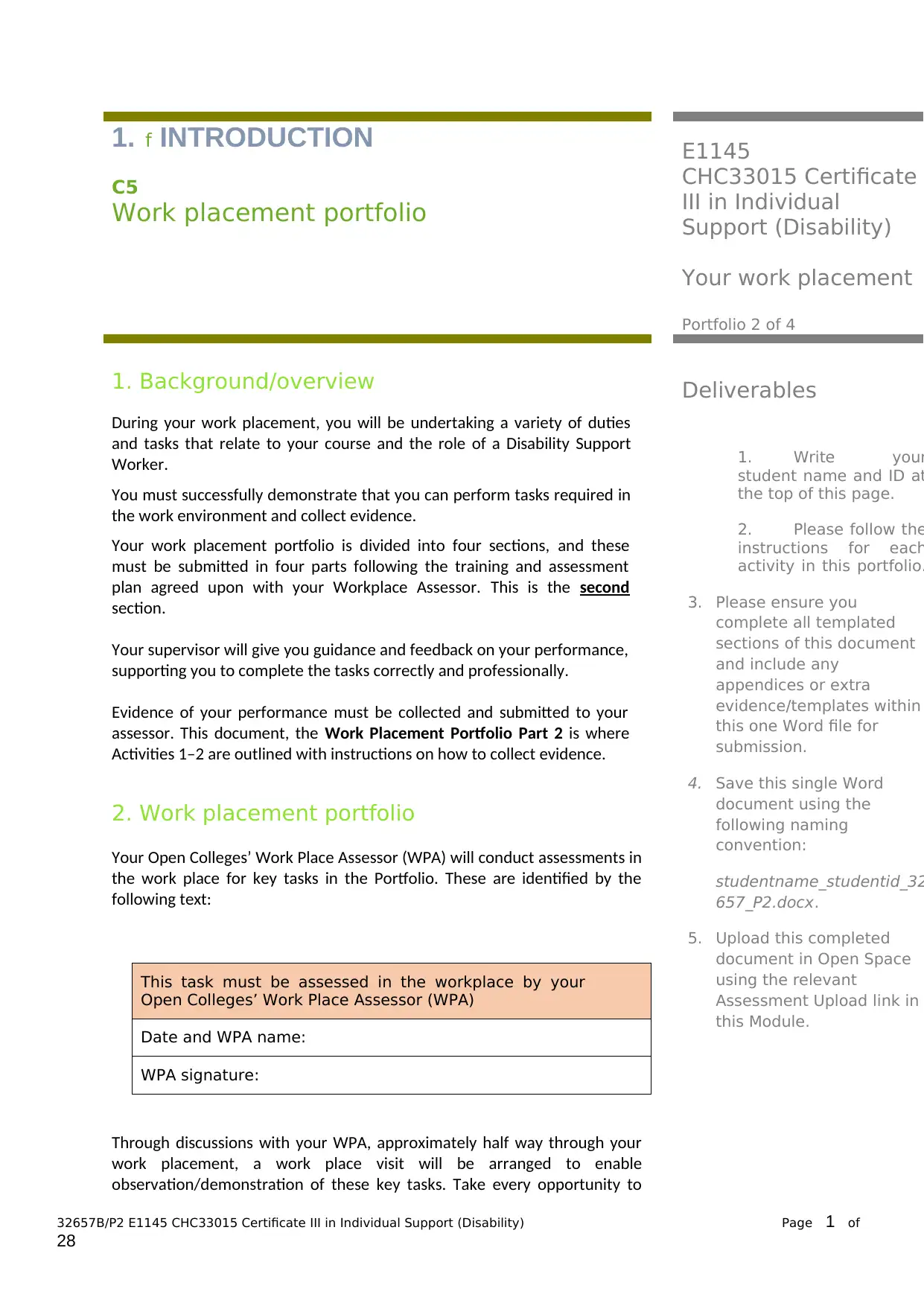
1. f INTRODUCTION
C5
Work placement portfolio
E1145
CHC33015 Certificate
III in Individual
Support (Disability)
Your work placement
Portfolio 2 of 4
1. Background/overview
During your work placement, you will be undertaking a variety of duties
and tasks that relate to your course and the role of a Disability Support
Worker.
You must successfully demonstrate that you can perform tasks required in
the work environment and collect evidence.
Your work placement portfolio is divided into four sections, and these
must be submitted in four parts following the training and assessment
plan agreed upon with your Workplace Assessor. This is the second
section.
Your supervisor will give you guidance and feedback on your performance,
supporting you to complete the tasks correctly and professionally.
Evidence of your performance must be collected and submitted to your
assessor. This document, the Work Placement Portfolio Part 2 is where
Activities 1–2 are outlined with instructions on how to collect evidence.
2. Work placement portfolio
Your Open Colleges’ Work Place Assessor (WPA) will conduct assessments in
the work place for key tasks in the Portfolio. These are identified by the
following text:
Through discussions with your WPA, approximately half way through your
work placement, a work place visit will be arranged to enable
observation/demonstration of these key tasks. Take every opportunity to
Deliverables
1. Write your
student name and ID at
the top of this page.
2. Please follow the
instructions for each
activity in this portfolio.
3. Please ensure you
complete all templated
sections of this document
and include any
appendices or extra
evidence/templates within
this one Word file for
submission.
4. Save this single Word
document using the
following naming
convention:
studentname_studentid_32
657_P2.docx.
5. Upload this completed
document in Open Space
using the relevant
Assessment Upload link in
this Module.
32657B/P2 E1145 CHC33015 Certificate III in Individual Support (Disability) Page 1 of
28
This task must be assessed in the workplace by your
Open Colleges’ Work Place Assessor (WPA)
Date and WPA name:
WPA signature:
C5
Work placement portfolio
E1145
CHC33015 Certificate
III in Individual
Support (Disability)
Your work placement
Portfolio 2 of 4
1. Background/overview
During your work placement, you will be undertaking a variety of duties
and tasks that relate to your course and the role of a Disability Support
Worker.
You must successfully demonstrate that you can perform tasks required in
the work environment and collect evidence.
Your work placement portfolio is divided into four sections, and these
must be submitted in four parts following the training and assessment
plan agreed upon with your Workplace Assessor. This is the second
section.
Your supervisor will give you guidance and feedback on your performance,
supporting you to complete the tasks correctly and professionally.
Evidence of your performance must be collected and submitted to your
assessor. This document, the Work Placement Portfolio Part 2 is where
Activities 1–2 are outlined with instructions on how to collect evidence.
2. Work placement portfolio
Your Open Colleges’ Work Place Assessor (WPA) will conduct assessments in
the work place for key tasks in the Portfolio. These are identified by the
following text:
Through discussions with your WPA, approximately half way through your
work placement, a work place visit will be arranged to enable
observation/demonstration of these key tasks. Take every opportunity to
Deliverables
1. Write your
student name and ID at
the top of this page.
2. Please follow the
instructions for each
activity in this portfolio.
3. Please ensure you
complete all templated
sections of this document
and include any
appendices or extra
evidence/templates within
this one Word file for
submission.
4. Save this single Word
document using the
following naming
convention:
studentname_studentid_32
657_P2.docx.
5. Upload this completed
document in Open Space
using the relevant
Assessment Upload link in
this Module.
32657B/P2 E1145 CHC33015 Certificate III in Individual Support (Disability) Page 1 of
28
This task must be assessed in the workplace by your
Open Colleges’ Work Place Assessor (WPA)
Date and WPA name:
WPA signature:
Paraphrase This Document
Need a fresh take? Get an instant paraphrase of this document with our AI Paraphraser
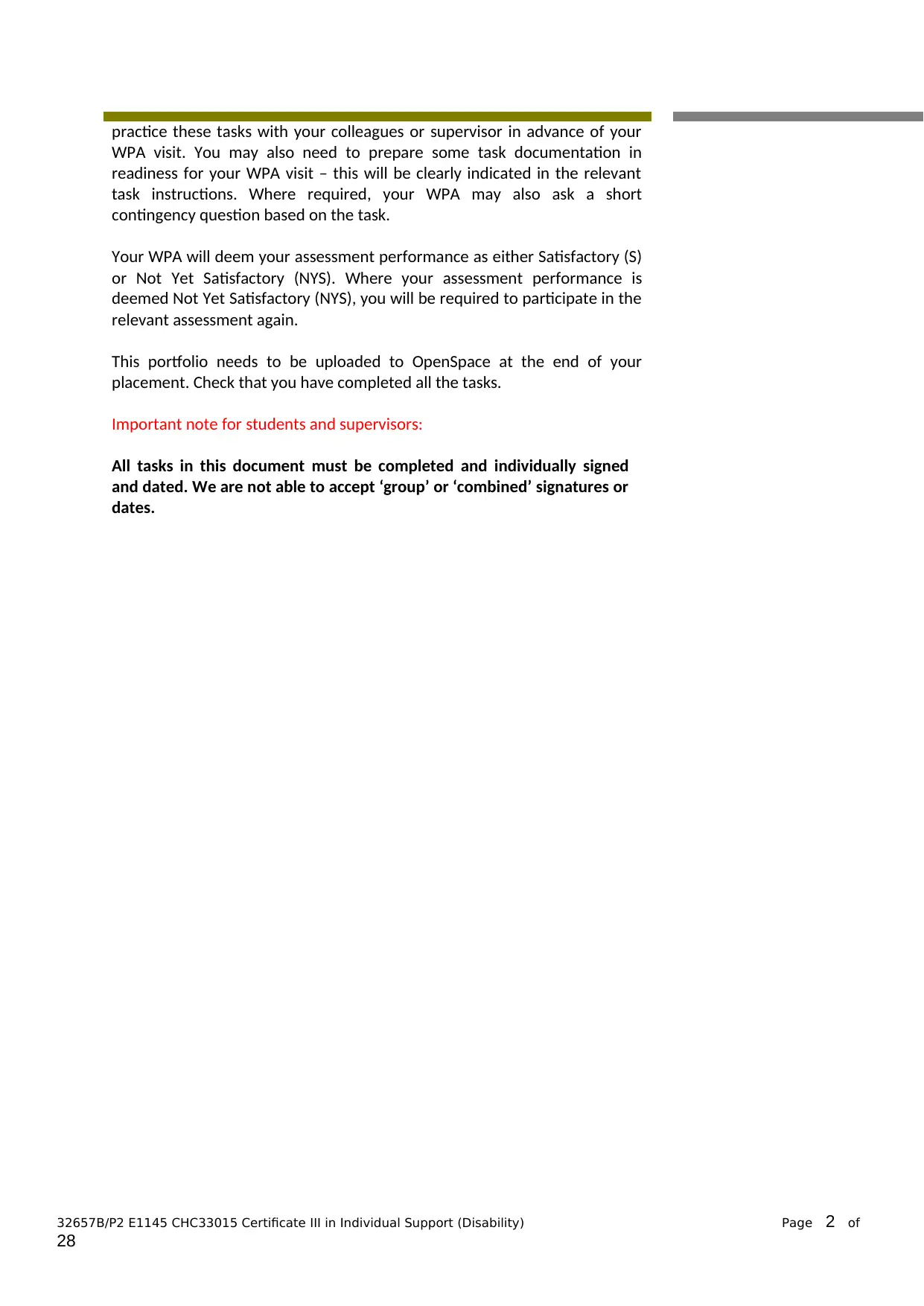
practice these tasks with your colleagues or supervisor in advance of your
WPA visit. You may also need to prepare some task documentation in
readiness for your WPA visit – this will be clearly indicated in the relevant
task instructions. Where required, your WPA may also ask a short
contingency question based on the task.
Your WPA will deem your assessment performance as either Satisfactory (S)
or Not Yet Satisfactory (NYS). Where your assessment performance is
deemed Not Yet Satisfactory (NYS), you will be required to participate in the
relevant assessment again.
This portfolio needs to be uploaded to OpenSpace at the end of your
placement. Check that you have completed all the tasks.
Important note for students and supervisors:
All tasks in this document must be completed and individually signed
and dated. We are not able to accept ‘group’ or ‘combined’ signatures or
dates.
32657B/P2 E1145 CHC33015 Certificate III in Individual Support (Disability) Page 2 of
28
WPA visit. You may also need to prepare some task documentation in
readiness for your WPA visit – this will be clearly indicated in the relevant
task instructions. Where required, your WPA may also ask a short
contingency question based on the task.
Your WPA will deem your assessment performance as either Satisfactory (S)
or Not Yet Satisfactory (NYS). Where your assessment performance is
deemed Not Yet Satisfactory (NYS), you will be required to participate in the
relevant assessment again.
This portfolio needs to be uploaded to OpenSpace at the end of your
placement. Check that you have completed all the tasks.
Important note for students and supervisors:
All tasks in this document must be completed and individually signed
and dated. We are not able to accept ‘group’ or ‘combined’ signatures or
dates.
32657B/P2 E1145 CHC33015 Certificate III in Individual Support (Disability) Page 2 of
28
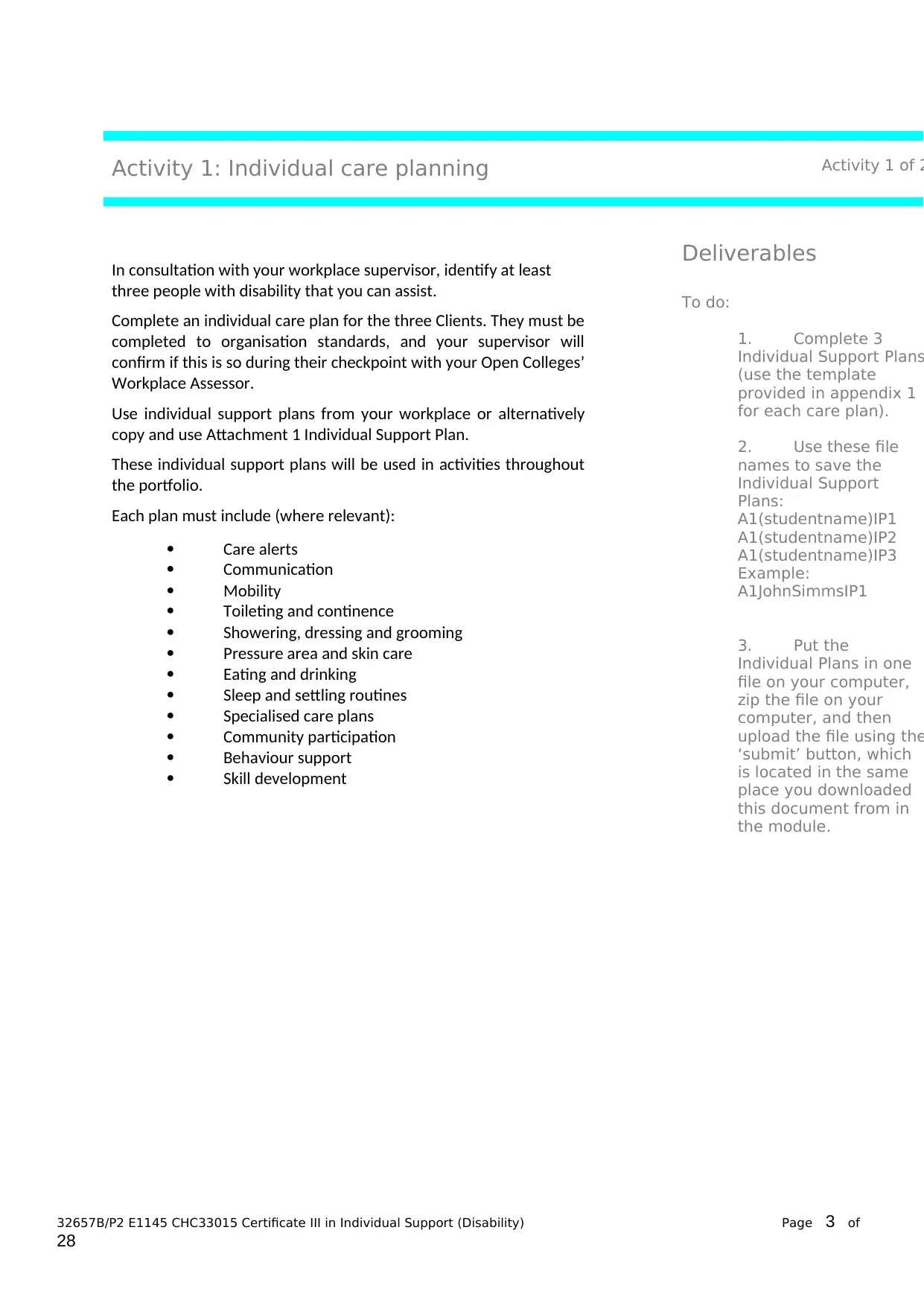
Activity 1: Individual care planning Activity 1 of 2
In consultation with your workplace supervisor, identify at least
three people with disability that you can assist.
Complete an individual care plan for the three Clients. They must be
completed to organisation standards, and your supervisor will
confirm if this is so during their checkpoint with your Open Colleges’
Workplace Assessor.
Use individual support plans from your workplace or alternatively
copy and use Attachment 1 Individual Support Plan.
These individual support plans will be used in activities throughout
the portfolio.
Each plan must include (where relevant):
Care alerts
Communication
Mobility
Toileting and continence
Showering, dressing and grooming
Pressure area and skin care
Eating and drinking
Sleep and settling routines
Specialised care plans
Community participation
Behaviour support
Skill development
Deliverables
To do:
1. Complete 3
Individual Support Plans
(use the template
provided in appendix 1
for each care plan).
2. Use these file
names to save the
Individual Support
Plans:
A1(studentname)IP1
A1(studentname)IP2
A1(studentname)IP3
Example:
A1JohnSimmsIP1
3. Put the
Individual Plans in one
file on your computer,
zip the file on your
computer, and then
upload the file using the
‘submit’ button, which
is located in the same
place you downloaded
this document from in
the module.
32657B/P2 E1145 CHC33015 Certificate III in Individual Support (Disability) Page 3 of
28
In consultation with your workplace supervisor, identify at least
three people with disability that you can assist.
Complete an individual care plan for the three Clients. They must be
completed to organisation standards, and your supervisor will
confirm if this is so during their checkpoint with your Open Colleges’
Workplace Assessor.
Use individual support plans from your workplace or alternatively
copy and use Attachment 1 Individual Support Plan.
These individual support plans will be used in activities throughout
the portfolio.
Each plan must include (where relevant):
Care alerts
Communication
Mobility
Toileting and continence
Showering, dressing and grooming
Pressure area and skin care
Eating and drinking
Sleep and settling routines
Specialised care plans
Community participation
Behaviour support
Skill development
Deliverables
To do:
1. Complete 3
Individual Support Plans
(use the template
provided in appendix 1
for each care plan).
2. Use these file
names to save the
Individual Support
Plans:
A1(studentname)IP1
A1(studentname)IP2
A1(studentname)IP3
Example:
A1JohnSimmsIP1
3. Put the
Individual Plans in one
file on your computer,
zip the file on your
computer, and then
upload the file using the
‘submit’ button, which
is located in the same
place you downloaded
this document from in
the module.
32657B/P2 E1145 CHC33015 Certificate III in Individual Support (Disability) Page 3 of
28
⊘ This is a preview!⊘
Do you want full access?
Subscribe today to unlock all pages.

Trusted by 1+ million students worldwide
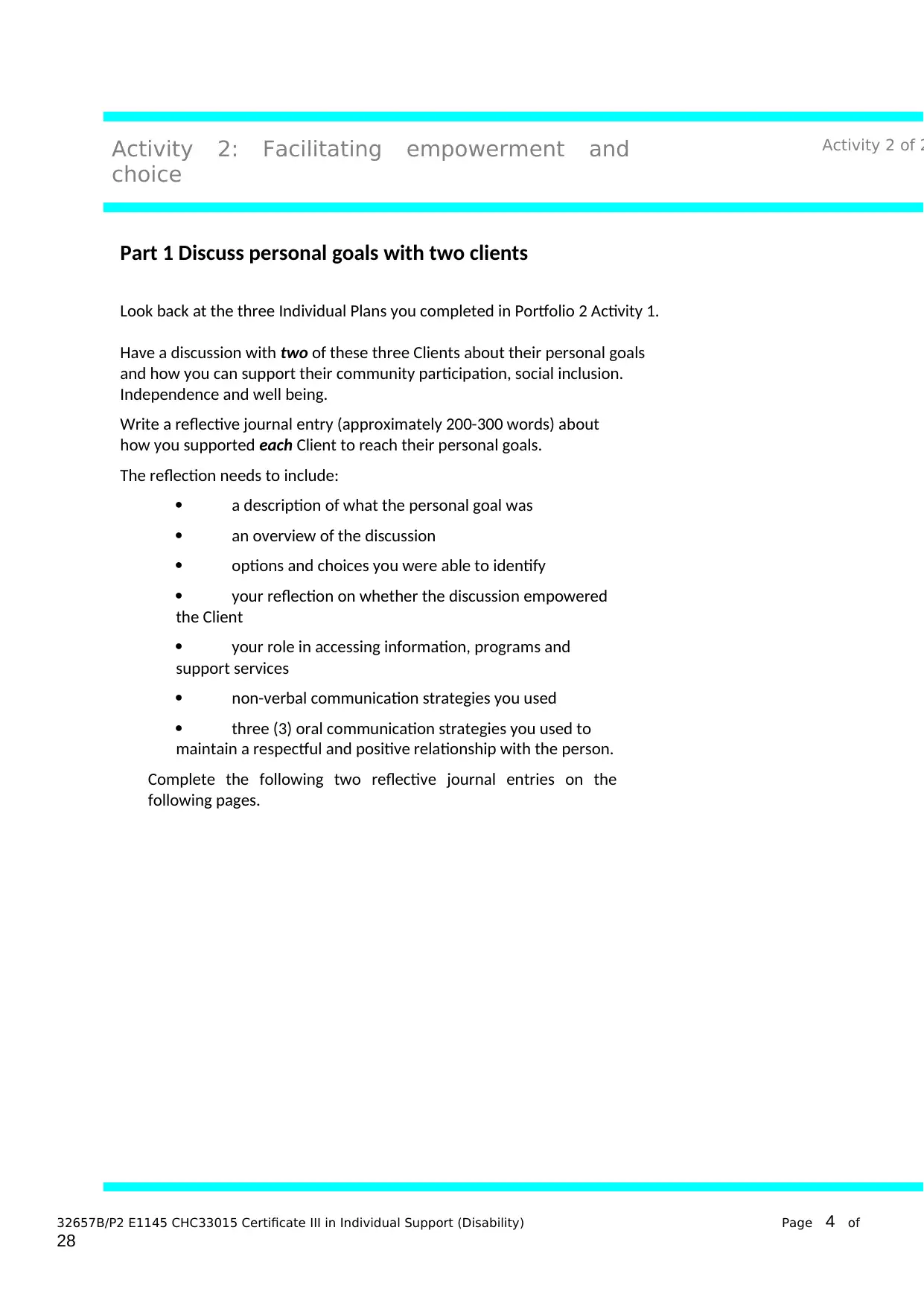
Activity 2: Facilitating empowerment and
choice
Activity 2 of 2
Part 1 Discuss personal goals with two clients
Look back at the three Individual Plans you completed in Portfolio 2 Activity 1.
Have a discussion with two of these three Clients about their personal goals
and how you can support their community participation, social inclusion.
Independence and well being.
Write a reflective journal entry (approximately 200-300 words) about
how you supported each Client to reach their personal goals.
The reflection needs to include:
a description of what the personal goal was
an overview of the discussion
options and choices you were able to identify
your reflection on whether the discussion empowered
the Client
your role in accessing information, programs and
support services
non-verbal communication strategies you used
three (3) oral communication strategies you used to
maintain a respectful and positive relationship with the person.
Complete the following two reflective journal entries on the
following pages.
32657B/P2 E1145 CHC33015 Certificate III in Individual Support (Disability) Page 4 of
28
choice
Activity 2 of 2
Part 1 Discuss personal goals with two clients
Look back at the three Individual Plans you completed in Portfolio 2 Activity 1.
Have a discussion with two of these three Clients about their personal goals
and how you can support their community participation, social inclusion.
Independence and well being.
Write a reflective journal entry (approximately 200-300 words) about
how you supported each Client to reach their personal goals.
The reflection needs to include:
a description of what the personal goal was
an overview of the discussion
options and choices you were able to identify
your reflection on whether the discussion empowered
the Client
your role in accessing information, programs and
support services
non-verbal communication strategies you used
three (3) oral communication strategies you used to
maintain a respectful and positive relationship with the person.
Complete the following two reflective journal entries on the
following pages.
32657B/P2 E1145 CHC33015 Certificate III in Individual Support (Disability) Page 4 of
28
Paraphrase This Document
Need a fresh take? Get an instant paraphrase of this document with our AI Paraphraser

32657B/P2 E1145 CHC33015 Certificate III in Individual Support (Disability) Page 5 of
28
28
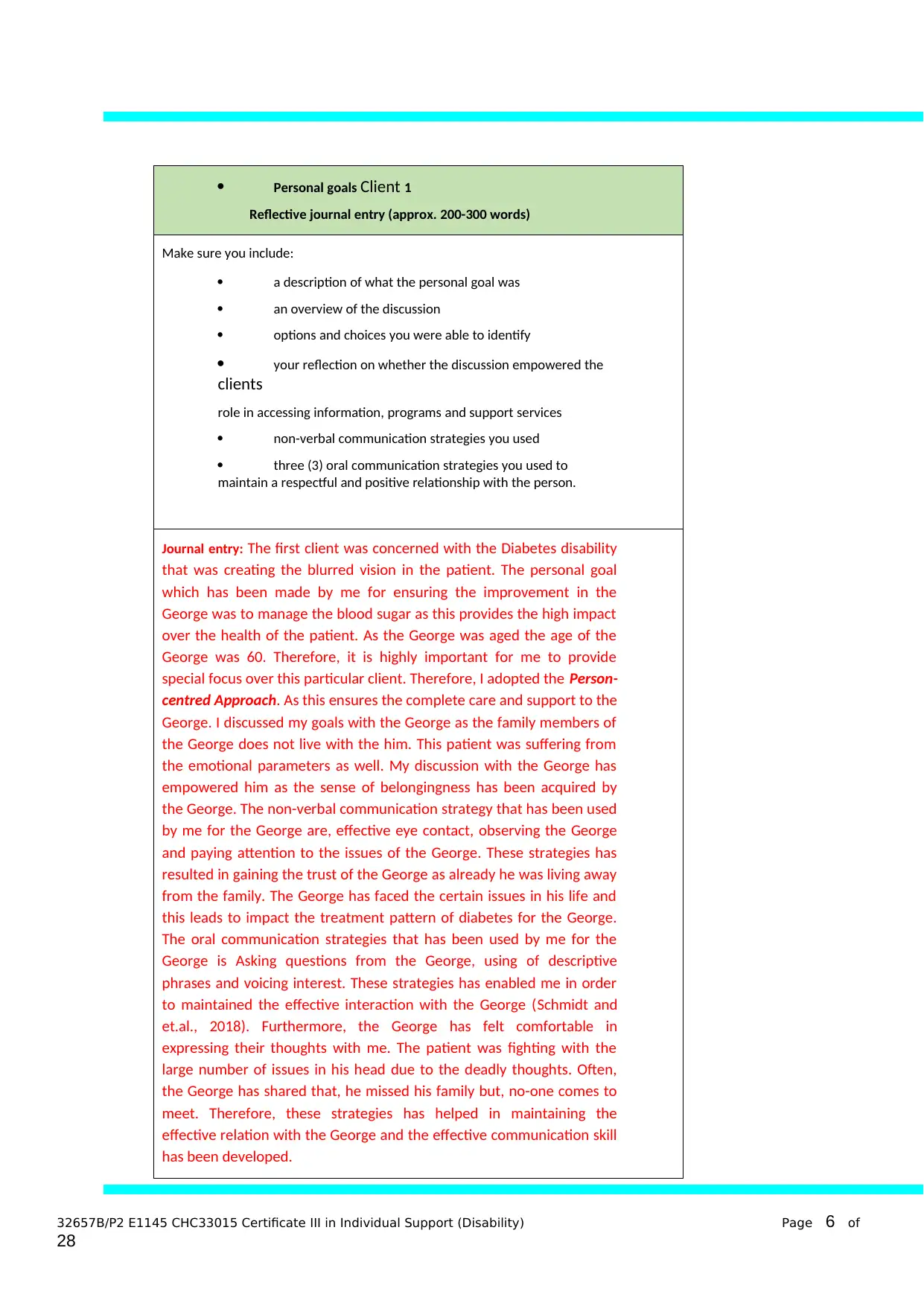
32657B/P2 E1145 CHC33015 Certificate III in Individual Support (Disability) Page 6 of
28
Personal goals Client 1
Reflective journal entry (approx. 200-300 words)
Make sure you include:
a description of what the personal goal was
an overview of the discussion
options and choices you were able to identify
your reflection on whether the discussion empowered the
clients
role in accessing information, programs and support services
non-verbal communication strategies you used
three (3) oral communication strategies you used to
maintain a respectful and positive relationship with the person.
Journal entry: The first client was concerned with the Diabetes disability
that was creating the blurred vision in the patient. The personal goal
which has been made by me for ensuring the improvement in the
George was to manage the blood sugar as this provides the high impact
over the health of the patient. As the George was aged the age of the
George was 60. Therefore, it is highly important for me to provide
special focus over this particular client. Therefore, I adopted the Person-
centred Approach. As this ensures the complete care and support to the
George. I discussed my goals with the George as the family members of
the George does not live with the him. This patient was suffering from
the emotional parameters as well. My discussion with the George has
empowered him as the sense of belongingness has been acquired by
the George. The non-verbal communication strategy that has been used
by me for the George are, effective eye contact, observing the George
and paying attention to the issues of the George. These strategies has
resulted in gaining the trust of the George as already he was living away
from the family. The George has faced the certain issues in his life and
this leads to impact the treatment pattern of diabetes for the George.
The oral communication strategies that has been used by me for the
George is Asking questions from the George, using of descriptive
phrases and voicing interest. These strategies has enabled me in order
to maintained the effective interaction with the George (Schmidt and
et.al., 2018). Furthermore, the George has felt comfortable in
expressing their thoughts with me. The patient was fighting with the
large number of issues in his head due to the deadly thoughts. Often,
the George has shared that, he missed his family but, no-one comes to
meet. Therefore, these strategies has helped in maintaining the
effective relation with the George and the effective communication skill
has been developed.
28
Personal goals Client 1
Reflective journal entry (approx. 200-300 words)
Make sure you include:
a description of what the personal goal was
an overview of the discussion
options and choices you were able to identify
your reflection on whether the discussion empowered the
clients
role in accessing information, programs and support services
non-verbal communication strategies you used
three (3) oral communication strategies you used to
maintain a respectful and positive relationship with the person.
Journal entry: The first client was concerned with the Diabetes disability
that was creating the blurred vision in the patient. The personal goal
which has been made by me for ensuring the improvement in the
George was to manage the blood sugar as this provides the high impact
over the health of the patient. As the George was aged the age of the
George was 60. Therefore, it is highly important for me to provide
special focus over this particular client. Therefore, I adopted the Person-
centred Approach. As this ensures the complete care and support to the
George. I discussed my goals with the George as the family members of
the George does not live with the him. This patient was suffering from
the emotional parameters as well. My discussion with the George has
empowered him as the sense of belongingness has been acquired by
the George. The non-verbal communication strategy that has been used
by me for the George are, effective eye contact, observing the George
and paying attention to the issues of the George. These strategies has
resulted in gaining the trust of the George as already he was living away
from the family. The George has faced the certain issues in his life and
this leads to impact the treatment pattern of diabetes for the George.
The oral communication strategies that has been used by me for the
George is Asking questions from the George, using of descriptive
phrases and voicing interest. These strategies has enabled me in order
to maintained the effective interaction with the George (Schmidt and
et.al., 2018). Furthermore, the George has felt comfortable in
expressing their thoughts with me. The patient was fighting with the
large number of issues in his head due to the deadly thoughts. Often,
the George has shared that, he missed his family but, no-one comes to
meet. Therefore, these strategies has helped in maintaining the
effective relation with the George and the effective communication skill
has been developed.
⊘ This is a preview!⊘
Do you want full access?
Subscribe today to unlock all pages.

Trusted by 1+ million students worldwide
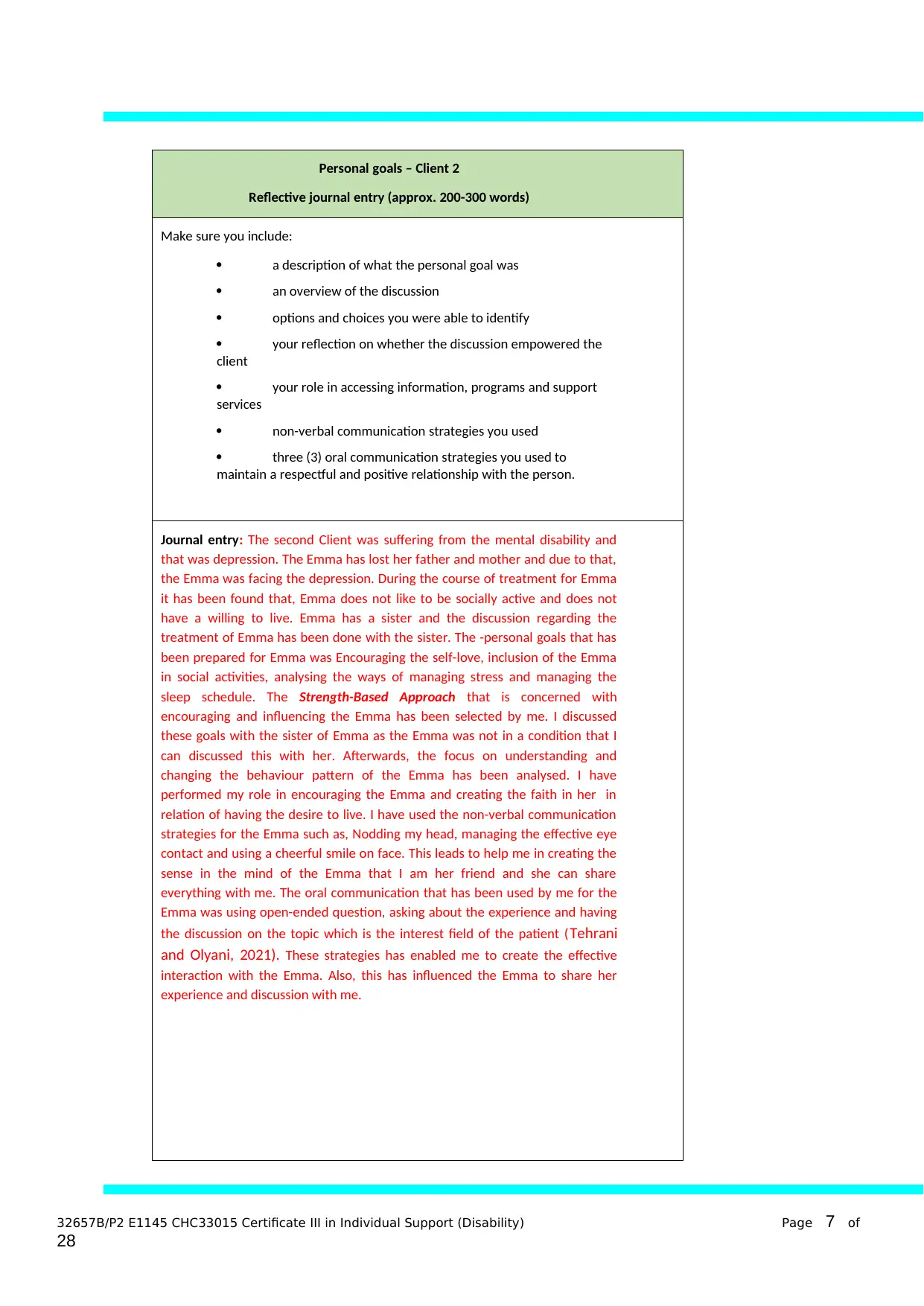
32657B/P2 E1145 CHC33015 Certificate III in Individual Support (Disability) Page 7 of
28
Personal goals – Client 2
Reflective journal entry (approx. 200-300 words)
Make sure you include:
a description of what the personal goal was
an overview of the discussion
options and choices you were able to identify
your reflection on whether the discussion empowered the
client
your role in accessing information, programs and support
services
non-verbal communication strategies you used
three (3) oral communication strategies you used to
maintain a respectful and positive relationship with the person.
Journal entry: The second Client was suffering from the mental disability and
that was depression. The Emma has lost her father and mother and due to that,
the Emma was facing the depression. During the course of treatment for Emma
it has been found that, Emma does not like to be socially active and does not
have a willing to live. Emma has a sister and the discussion regarding the
treatment of Emma has been done with the sister. The -personal goals that has
been prepared for Emma was Encouraging the self-love, inclusion of the Emma
in social activities, analysing the ways of managing stress and managing the
sleep schedule. The Strength-Based Approach that is concerned with
encouraging and influencing the Emma has been selected by me. I discussed
these goals with the sister of Emma as the Emma was not in a condition that I
can discussed this with her. Afterwards, the focus on understanding and
changing the behaviour pattern of the Emma has been analysed. I have
performed my role in encouraging the Emma and creating the faith in her in
relation of having the desire to live. I have used the non-verbal communication
strategies for the Emma such as, Nodding my head, managing the effective eye
contact and using a cheerful smile on face. This leads to help me in creating the
sense in the mind of the Emma that I am her friend and she can share
everything with me. The oral communication that has been used by me for the
Emma was using open-ended question, asking about the experience and having
the discussion on the topic which is the interest field of the patient ( Tehrani
and Olyani, 2021). These strategies has enabled me to create the effective
interaction with the Emma. Also, this has influenced the Emma to share her
experience and discussion with me.
28
Personal goals – Client 2
Reflective journal entry (approx. 200-300 words)
Make sure you include:
a description of what the personal goal was
an overview of the discussion
options and choices you were able to identify
your reflection on whether the discussion empowered the
client
your role in accessing information, programs and support
services
non-verbal communication strategies you used
three (3) oral communication strategies you used to
maintain a respectful and positive relationship with the person.
Journal entry: The second Client was suffering from the mental disability and
that was depression. The Emma has lost her father and mother and due to that,
the Emma was facing the depression. During the course of treatment for Emma
it has been found that, Emma does not like to be socially active and does not
have a willing to live. Emma has a sister and the discussion regarding the
treatment of Emma has been done with the sister. The -personal goals that has
been prepared for Emma was Encouraging the self-love, inclusion of the Emma
in social activities, analysing the ways of managing stress and managing the
sleep schedule. The Strength-Based Approach that is concerned with
encouraging and influencing the Emma has been selected by me. I discussed
these goals with the sister of Emma as the Emma was not in a condition that I
can discussed this with her. Afterwards, the focus on understanding and
changing the behaviour pattern of the Emma has been analysed. I have
performed my role in encouraging the Emma and creating the faith in her in
relation of having the desire to live. I have used the non-verbal communication
strategies for the Emma such as, Nodding my head, managing the effective eye
contact and using a cheerful smile on face. This leads to help me in creating the
sense in the mind of the Emma that I am her friend and she can share
everything with me. The oral communication that has been used by me for the
Emma was using open-ended question, asking about the experience and having
the discussion on the topic which is the interest field of the patient ( Tehrani
and Olyani, 2021). These strategies has enabled me to create the effective
interaction with the Emma. Also, this has influenced the Emma to share her
experience and discussion with me.
Paraphrase This Document
Need a fresh take? Get an instant paraphrase of this document with our AI Paraphraser
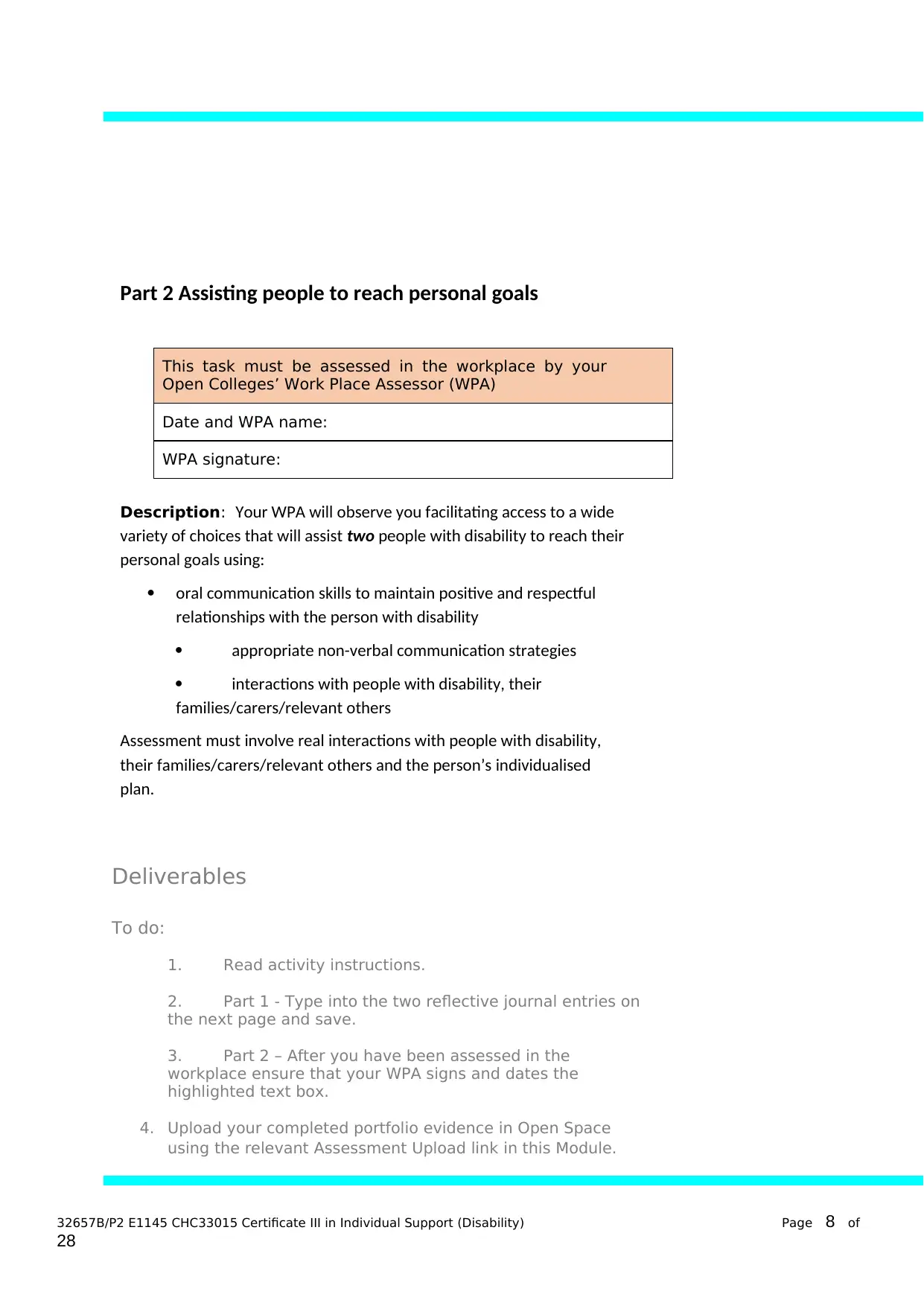
Part 2 Assisting people to reach personal goals
Description: Your WPA will observe you facilitating access to a wide
variety of choices that will assist two people with disability to reach their
personal goals using:
oral communication skills to maintain positive and respectful
relationships with the person with disability
appropriate non-verbal communication strategies
interactions with people with disability, their
families/carers/relevant others
Assessment must involve real interactions with people with disability,
their families/carers/relevant others and the person’s individualised
plan.
Deliverables
To do:
1. Read activity instructions.
2. Part 1 - Type into the two reflective journal entries on
the next page and save.
3. Part 2 – After you have been assessed in the
workplace ensure that your WPA signs and dates the
highlighted text box.
4. Upload your completed portfolio evidence in Open Space
using the relevant Assessment Upload link in this Module.
32657B/P2 E1145 CHC33015 Certificate III in Individual Support (Disability) Page 8 of
28
This task must be assessed in the workplace by your
Open Colleges’ Work Place Assessor (WPA)
Date and WPA name:
WPA signature:
Description: Your WPA will observe you facilitating access to a wide
variety of choices that will assist two people with disability to reach their
personal goals using:
oral communication skills to maintain positive and respectful
relationships with the person with disability
appropriate non-verbal communication strategies
interactions with people with disability, their
families/carers/relevant others
Assessment must involve real interactions with people with disability,
their families/carers/relevant others and the person’s individualised
plan.
Deliverables
To do:
1. Read activity instructions.
2. Part 1 - Type into the two reflective journal entries on
the next page and save.
3. Part 2 – After you have been assessed in the
workplace ensure that your WPA signs and dates the
highlighted text box.
4. Upload your completed portfolio evidence in Open Space
using the relevant Assessment Upload link in this Module.
32657B/P2 E1145 CHC33015 Certificate III in Individual Support (Disability) Page 8 of
28
This task must be assessed in the workplace by your
Open Colleges’ Work Place Assessor (WPA)
Date and WPA name:
WPA signature:
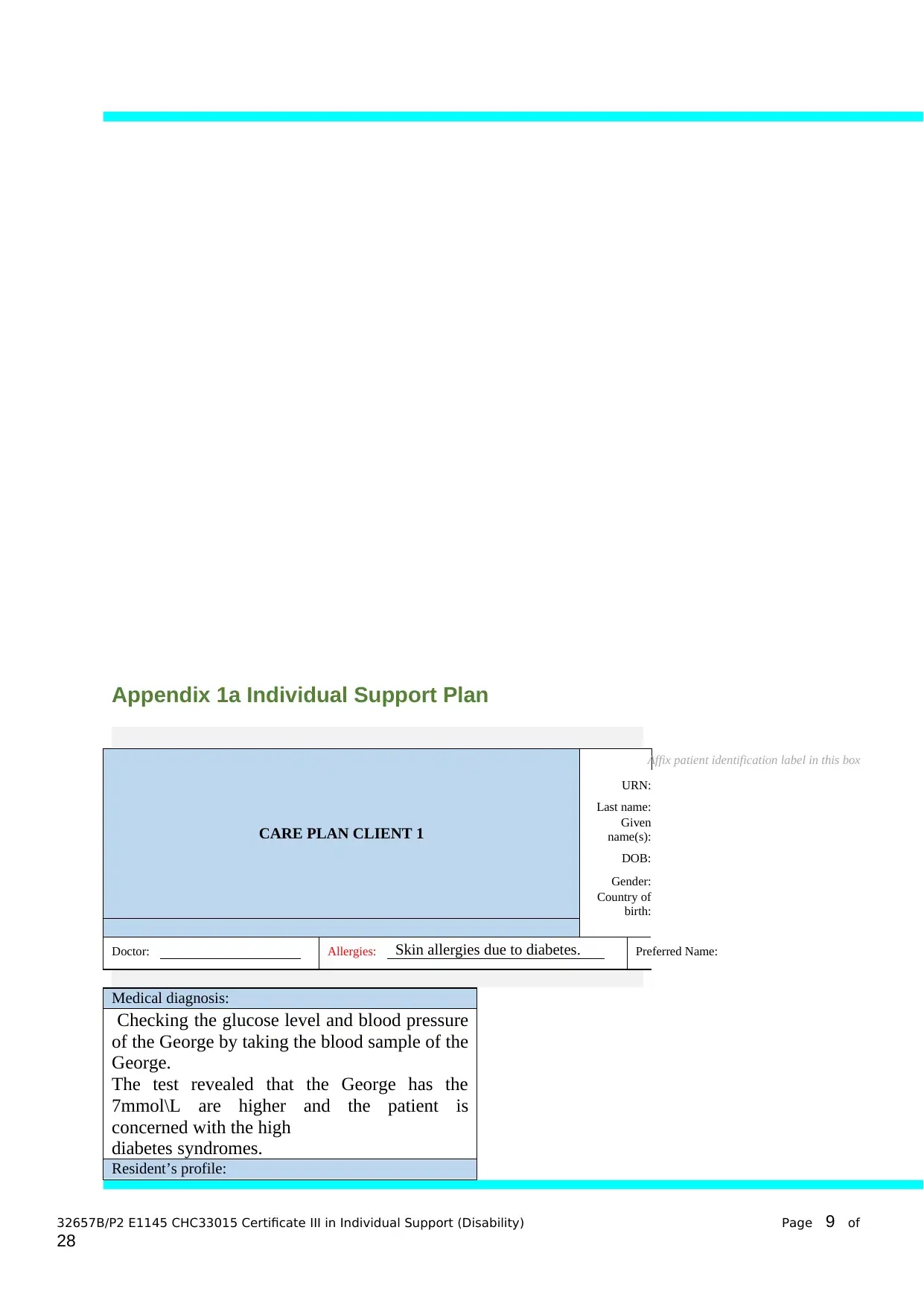
Appendix 1a Individual Support Plan
CARE PLAN CLIENT 1
Affix patient identification label in this box
URN:
Last name:
Given
name(s):
DOB:
Gender:
Country of
birth:
Doctor: Allergies: Skin allergies due to diabetes. Preferred Name:
Medical diagnosis:
Checking the glucose level and blood pressure
of the George by taking the blood sample of the
George.
The test revealed that the George has the
7mmol\L are higher and the patient is
concerned with the high
diabetes syndromes.
Resident’s profile:
32657B/P2 E1145 CHC33015 Certificate III in Individual Support (Disability) Page 9 of
28
CARE PLAN CLIENT 1
Affix patient identification label in this box
URN:
Last name:
Given
name(s):
DOB:
Gender:
Country of
birth:
Doctor: Allergies: Skin allergies due to diabetes. Preferred Name:
Medical diagnosis:
Checking the glucose level and blood pressure
of the George by taking the blood sample of the
George.
The test revealed that the George has the
7mmol\L are higher and the patient is
concerned with the high
diabetes syndromes.
Resident’s profile:
32657B/P2 E1145 CHC33015 Certificate III in Individual Support (Disability) Page 9 of
28
⊘ This is a preview!⊘
Do you want full access?
Subscribe today to unlock all pages.

Trusted by 1+ million students worldwide
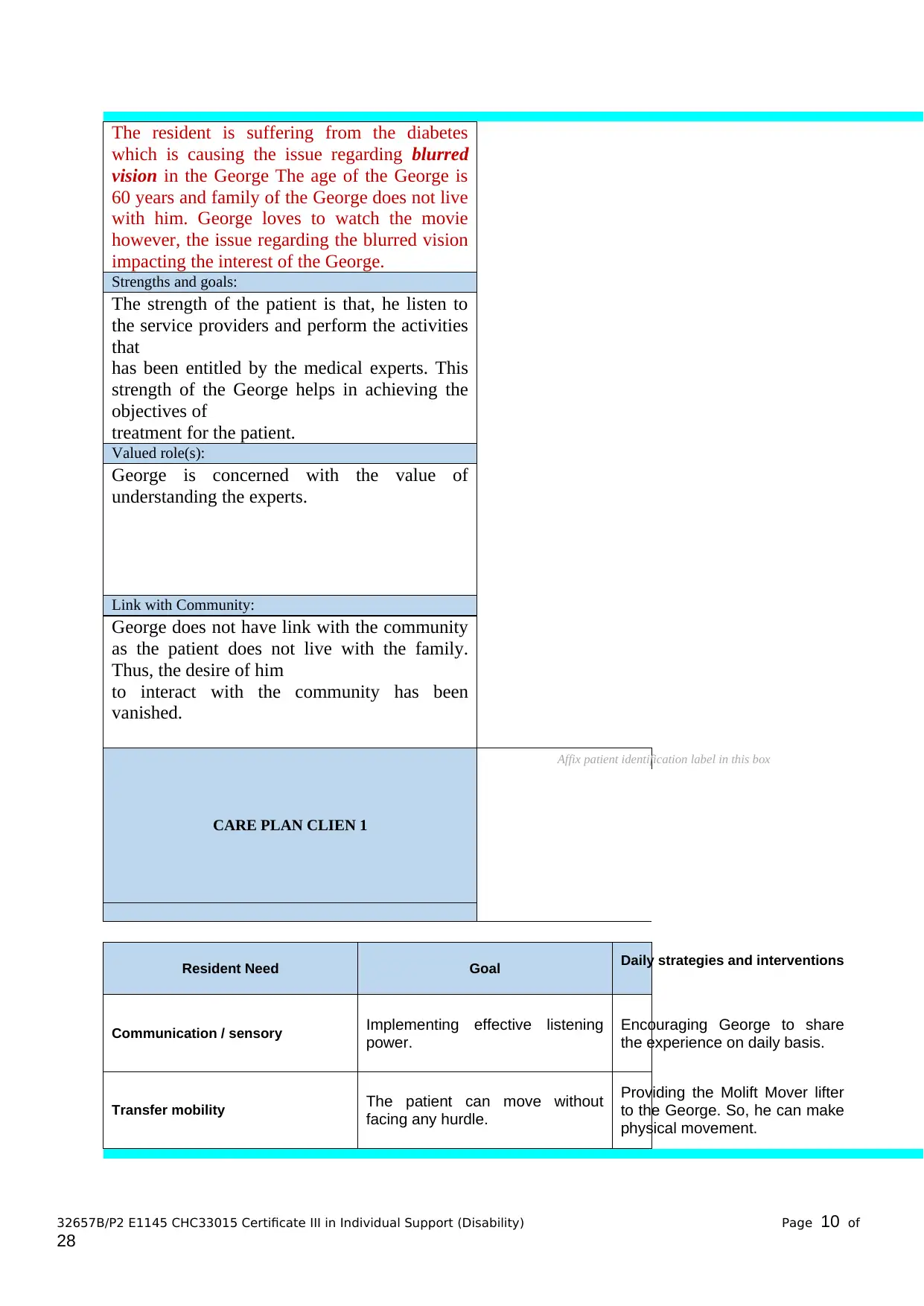
The resident is suffering from the diabetes
which is causing the issue regarding blurred
vision in the George The age of the George is
60 years and family of the George does not live
with him. George loves to watch the movie
however, the issue regarding the blurred vision
impacting the interest of the George.
Strengths and goals:
The strength of the patient is that, he listen to
the service providers and perform the activities
that
has been entitled by the medical experts. This
strength of the George helps in achieving the
objectives of
treatment for the patient.
Valued role(s):
George is concerned with the value of
understanding the experts.
Link with Community:
George does not have link with the community
as the patient does not live with the family.
Thus, the desire of him
to interact with the community has been
vanished.
CARE PLAN CLIEN 1
Affix patient identification label in this box
Resident Need Goal Daily strategies and interventions
Communication / sensory Implementing effective listening
power.
Encouraging George to share
the experience on daily basis.
Transfer mobility The patient can move without
facing any hurdle.
Providing the Molift Mover lifter
to the George. So, he can make
physical movement.
32657B/P2 E1145 CHC33015 Certificate III in Individual Support (Disability) Page 10 of
28
which is causing the issue regarding blurred
vision in the George The age of the George is
60 years and family of the George does not live
with him. George loves to watch the movie
however, the issue regarding the blurred vision
impacting the interest of the George.
Strengths and goals:
The strength of the patient is that, he listen to
the service providers and perform the activities
that
has been entitled by the medical experts. This
strength of the George helps in achieving the
objectives of
treatment for the patient.
Valued role(s):
George is concerned with the value of
understanding the experts.
Link with Community:
George does not have link with the community
as the patient does not live with the family.
Thus, the desire of him
to interact with the community has been
vanished.
CARE PLAN CLIEN 1
Affix patient identification label in this box
Resident Need Goal Daily strategies and interventions
Communication / sensory Implementing effective listening
power.
Encouraging George to share
the experience on daily basis.
Transfer mobility The patient can move without
facing any hurdle.
Providing the Molift Mover lifter
to the George. So, he can make
physical movement.
32657B/P2 E1145 CHC33015 Certificate III in Individual Support (Disability) Page 10 of
28
Paraphrase This Document
Need a fresh take? Get an instant paraphrase of this document with our AI Paraphraser
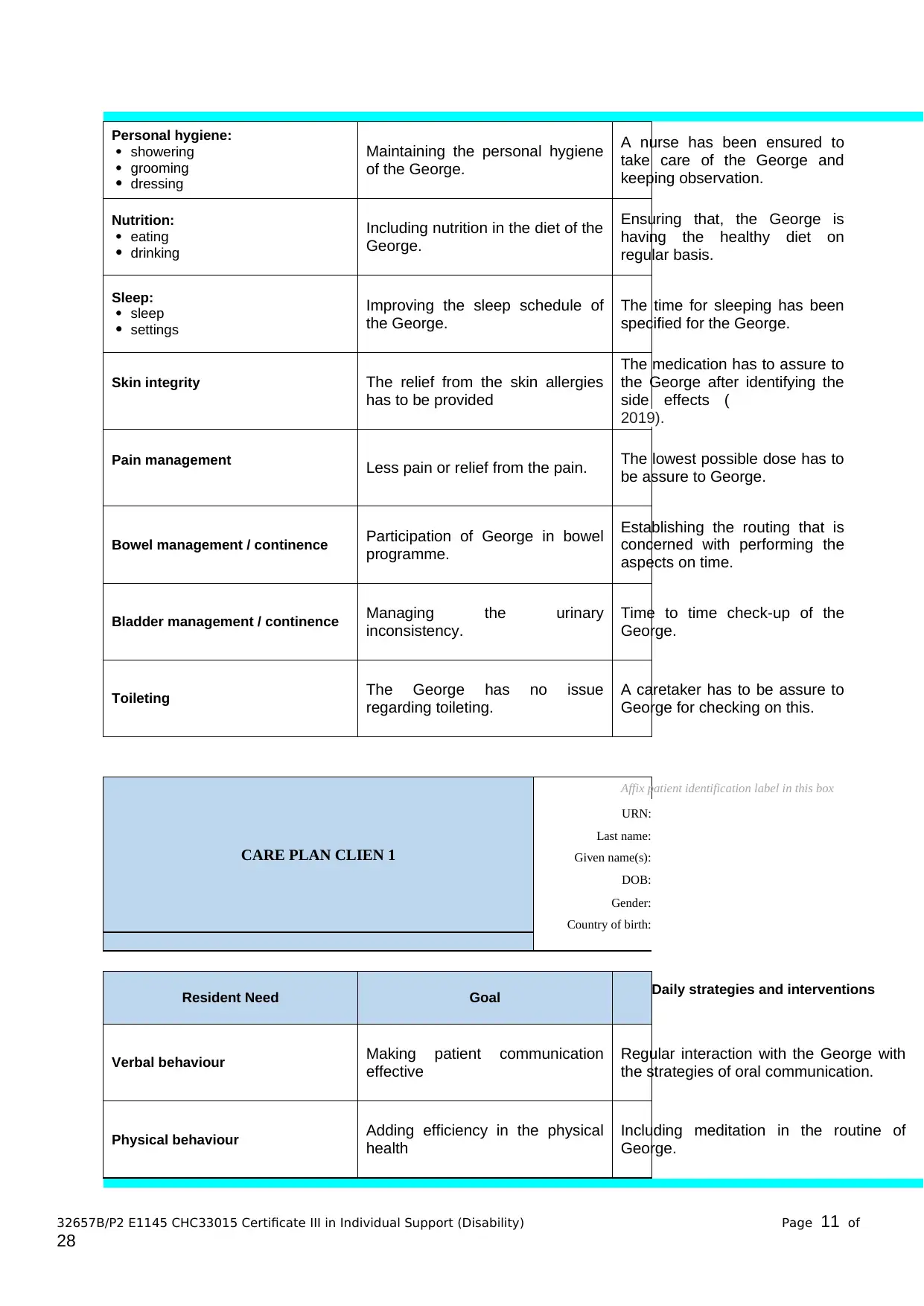
Personal hygiene:
showering
grooming
dressing
Maintaining the personal hygiene
of the George.
A nurse has been ensured to
take care of the George and
keeping observation.
Nutrition:
eating
drinking
Including nutrition in the diet of the
George.
Ensuring that, the George is
having the healthy diet on
regular basis.
Sleep:
sleep
settings
Improving the sleep schedule of
the George.
The time for sleeping has been
specified for the George.
Skin integrity The relief from the skin allergies
has to be provided
The medication has to assure to
the George after identifying the
side effects (
2019).
Pain management Less pain or relief from the pain. The lowest possible dose has to
be assure to George.
Bowel management / continence Participation of George in bowel
programme.
Establishing the routing that is
concerned with performing the
aspects on time.
Bladder management / continence Managing the urinary
inconsistency.
Time to time check-up of the
George.
Toileting The George has no issue
regarding toileting.
A caretaker has to be assure to
George for checking on this.
CARE PLAN CLIEN 1
Affix patient identification label in this box
URN:
Last name:
Given name(s):
DOB:
Gender:
Country of birth:
Resident Need Goal Daily strategies and interventions
Verbal behaviour Making patient communication
effective
Regular interaction with the George with
the strategies of oral communication.
Physical behaviour Adding efficiency in the physical
health
Including meditation in the routine of
George.
32657B/P2 E1145 CHC33015 Certificate III in Individual Support (Disability) Page 11 of
28
showering
grooming
dressing
Maintaining the personal hygiene
of the George.
A nurse has been ensured to
take care of the George and
keeping observation.
Nutrition:
eating
drinking
Including nutrition in the diet of the
George.
Ensuring that, the George is
having the healthy diet on
regular basis.
Sleep:
sleep
settings
Improving the sleep schedule of
the George.
The time for sleeping has been
specified for the George.
Skin integrity The relief from the skin allergies
has to be provided
The medication has to assure to
the George after identifying the
side effects (
2019).
Pain management Less pain or relief from the pain. The lowest possible dose has to
be assure to George.
Bowel management / continence Participation of George in bowel
programme.
Establishing the routing that is
concerned with performing the
aspects on time.
Bladder management / continence Managing the urinary
inconsistency.
Time to time check-up of the
George.
Toileting The George has no issue
regarding toileting.
A caretaker has to be assure to
George for checking on this.
CARE PLAN CLIEN 1
Affix patient identification label in this box
URN:
Last name:
Given name(s):
DOB:
Gender:
Country of birth:
Resident Need Goal Daily strategies and interventions
Verbal behaviour Making patient communication
effective
Regular interaction with the George with
the strategies of oral communication.
Physical behaviour Adding efficiency in the physical
health
Including meditation in the routine of
George.
32657B/P2 E1145 CHC33015 Certificate III in Individual Support (Disability) Page 11 of
28
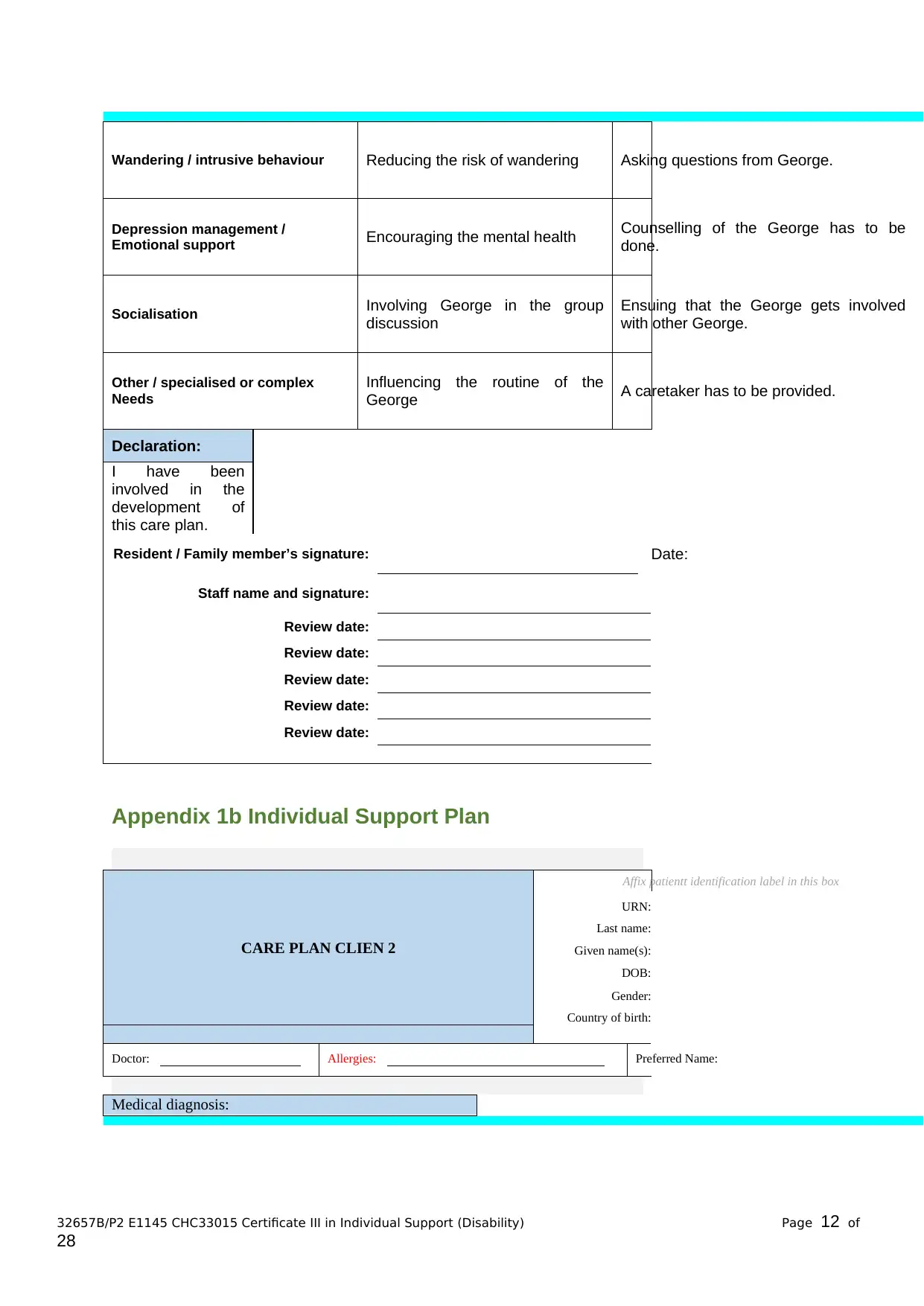
Wandering / intrusive behaviour Reducing the risk of wandering Asking questions from George.
Depression management /
Emotional support Encouraging the mental health Counselling of the George has to be
done.
Socialisation Involving George in the group
discussion
Ensuing that the George gets involved
with other George.
Other / specialised or complex
Needs
Influencing the routine of the
George A caretaker has to be provided.
Declaration:
I have been
involved in the
development of
this care plan.
Resident / Family member’s signature: Date:
Staff name and signature:
Review date:
Review date:
Review date:
Review date:
Review date:
Appendix 1b Individual Support Plan
CARE PLAN CLIEN 2
Affix patientt identification label in this box
URN:
Last name:
Given name(s):
DOB:
Gender:
Country of birth:
Doctor: Allergies: Preferred Name:
Medical diagnosis:
32657B/P2 E1145 CHC33015 Certificate III in Individual Support (Disability) Page 12 of
28
Depression management /
Emotional support Encouraging the mental health Counselling of the George has to be
done.
Socialisation Involving George in the group
discussion
Ensuing that the George gets involved
with other George.
Other / specialised or complex
Needs
Influencing the routine of the
George A caretaker has to be provided.
Declaration:
I have been
involved in the
development of
this care plan.
Resident / Family member’s signature: Date:
Staff name and signature:
Review date:
Review date:
Review date:
Review date:
Review date:
Appendix 1b Individual Support Plan
CARE PLAN CLIEN 2
Affix patientt identification label in this box
URN:
Last name:
Given name(s):
DOB:
Gender:
Country of birth:
Doctor: Allergies: Preferred Name:
Medical diagnosis:
32657B/P2 E1145 CHC33015 Certificate III in Individual Support (Disability) Page 12 of
28
⊘ This is a preview!⊘
Do you want full access?
Subscribe today to unlock all pages.

Trusted by 1+ million students worldwide
1 out of 28
Related Documents
Your All-in-One AI-Powered Toolkit for Academic Success.
+13062052269
info@desklib.com
Available 24*7 on WhatsApp / Email
![[object Object]](/_next/static/media/star-bottom.7253800d.svg)
Unlock your academic potential
Copyright © 2020–2025 A2Z Services. All Rights Reserved. Developed and managed by ZUCOL.





